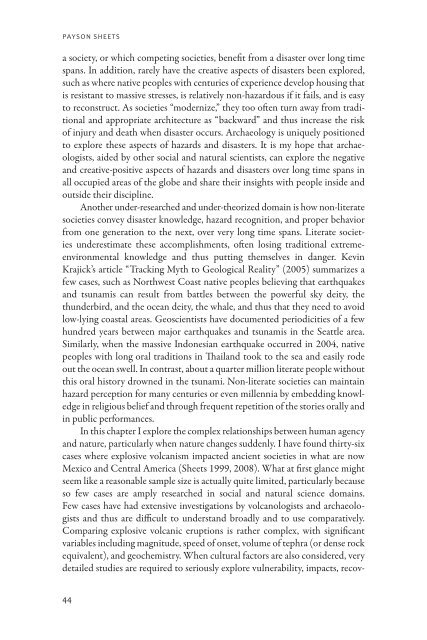free download - University Press of Colorado
free download - University Press of Colorado
free download - University Press of Colorado
You also want an ePaper? Increase the reach of your titles
YUMPU automatically turns print PDFs into web optimized ePapers that Google loves.
Payson Sheets<br />
a society, or which competing societies, benefit from a disaster over long time<br />
spans. In addition, rarely have the creative aspects <strong>of</strong> disasters been explored,<br />
such as where native peoples with centuries <strong>of</strong> experience develop housing that<br />
is resistant to massive stresses, is relatively non-hazardous if it fails, and is easy<br />
to reconstruct. As societies “modernize,” they too <strong>of</strong>ten turn away from traditional<br />
and appropriate architecture as “backward” and thus increase the risk<br />
<strong>of</strong> injury and death when disaster occurs. Archaeology is uniquely positioned<br />
to explore these aspects <strong>of</strong> hazards and disasters. It is my hope that archaeologists,<br />
aided by other social and natural scientists, can explore the negative<br />
and creative-positive aspects <strong>of</strong> hazards and disasters over long time spans in<br />
all occupied areas <strong>of</strong> the globe and share their insights with people inside and<br />
outside their discipline.<br />
Another under-researched and under-theorized domain is how non- literate<br />
societies convey disaster knowledge, hazard recognition, and proper behavior<br />
from one generation to the next, over very long time spans. Literate societies<br />
underestimate these accomplishments, <strong>of</strong>ten losing traditional extremeenvironmental<br />
knowledge and thus putting themselves in danger. Kevin<br />
Krajick’s article “Tracking Myth to Geological Reality” (2005) summarizes a<br />
few cases, such as Northwest Coast native peoples believing that earthquakes<br />
and tsunamis can result from battles between the powerful sky deity, the<br />
thunderbird, and the ocean deity, the whale, and thus that they need to avoid<br />
low-lying coastal areas. Geoscientists have documented periodicities <strong>of</strong> a few<br />
hundred years between major earthquakes and tsunamis in the Seattle area.<br />
Similarly, when the massive Indonesian earthquake occurred in 2004, native<br />
peoples with long oral traditions in Thailand took to the sea and easily rode<br />
out the ocean swell. In contrast, about a quarter million literate people without<br />
this oral history drowned in the tsunami. Non-literate societies can maintain<br />
hazard perception for many centuries or even millennia by embedding knowledge<br />
in religious belief and through frequent repetition <strong>of</strong> the stories orally and<br />
in public performances.<br />
In this chapter I explore the complex relationships between human agency<br />
and nature, particularly when nature changes suddenly. I have found thirty-six<br />
cases where explosive volcanism impacted ancient societies in what are now<br />
Mexico and Central America (Sheets 1999, 2008). What at first glance might<br />
seem like a reasonable sample size is actually quite limited, particularly because<br />
so few cases are amply researched in social and natural science domains.<br />
Few cases have had extensive investigations by volcanologists and archaeologists<br />
and thus are difficult to understand broadly and to use comparatively.<br />
Comparing explosive volcanic eruptions is rather complex, with significant<br />
variables including magnitude, speed <strong>of</strong> onset, volume <strong>of</strong> tephra (or dense rock<br />
equivalent), and geochemistry. When cultural factors are also considered, very<br />
detailed studies are required to seriously explore vulnerability, impacts, recov-<br />
44





